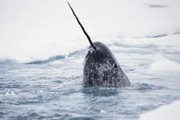The narwhal (Monodon monoceros), also known as a narwhale, is a medium-sized toothed whale that lives year-round in the Arctic. One of two living species of whale in the Monodontidae family, along with the beluga whale, narwhal males are distinguished by a long, straight, helical tusk, actually an elongated upper left canine. Found primarily in Canadian Arctic and Greenlandic waters, rarely south of 65°N latitude, the narwhal is a uniquely specialized Arctic predator. In the winter, it feeds on benthic prey, mostly flatfish, at depths of up to 1500 m under dense pack ice. Narwhals have been harvested for over a thousand years by Inuit people in northern Canada and Greenland for meat and ivory, and a regulated subsistence hunt continues to this day. While populations appear stable, the narwhal is particularly vulnerable to climate change due to a narrow geographical range and specialized diet.
Description[]
Narwhals are medium-sized whales, and equivalent to the size of beluga whales. Total length in both sexes, excluding the tusk of the male, can range from 3.95 to 5.5 m (13 to 18 ft). Males are slightly larger than females, at an average length of 4.1 m (13 ft 5 in), , with an average length of 3.5 m (11 ft 6 in). Typical adult body weight ranges from 800 to 1,600 kg (1,800 to 3,500 lb). Male narwhals attain sexual maturity at 11 to 13 years of age, when they are about 3.9 m (12 ft 10 in) long. Females become sexually mature at a younger age, between 5 to 8 years old, when they are around 3.4 m (11 ft 2 in) long.
The pigmentation of narwhals is a mottled pattern, with blackish-brown markings over a white background. They are darkest when born and become whiter with age; white patches develop on the navel and genital slit at sexual maturity. Their neck vertebrae are jointed, like those of land mammals, instead of being fused together as in most whales. Both these characteristics are shared by the beluga whale. The tail flukes of female narwhals have front edges that are swept back, and those of males have front edges that are more concave and lack a sweep-back. This is thought to be an adaptation for reducing drag caused by the tusk.
In the Wolves of the Beyond[]
Star Wolf[]
The narwhals play a major role in Star Wolf once on the Ice Bridge, because

A Narwhal with its "tusk" displayed.
Abban ends up falling into the sea, only to be saved by the narwhales and Gwynneth. Later on, when Faolan, Edme, and Gwynneth discuss Abban's condition, a pod of narwhales passes by and the two wolves are amazed. They are even more stunned when Gwynneth reveals that Abban actually saw them too, because he kept talking about one called Old Tooth. Faolan also reveals that Old Tooth can help them navigate safely on the ice, because Abban also mentioned that he will warn them whenever the ice cracks. Old Tooth and his narwhales follow the brigade on the ice, and help them swim while wambling.
Near the end of the book, Old Tooth and his pod of narwhales help the brigade after they fall into the sea during the final battle against Heep and his rout. Old Tooth kills Heep with his tusk and the narwhales instruct the animals to climb on their backs, with Abban acting as interpreter. The narwhales safely bring the brigade to the Distant Blue, and Abban says goodbye to them, watching until they are out of sight.
